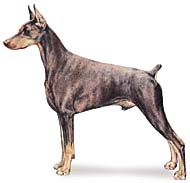
The Dobermann Pinscher (alternatively spelled Doberman in many countries) or Dobermann is a breed of domestic dog. Dobermann Pinschers are among the most common of pet breeds, and the breed is well known as an intelligent, alert, and loyal companion dog. Although once commonly used as guard dogs, watch dogs, or police dogs, this is less common today. In many countries, Dobermann Pinschers are one of the most recognizable breeds, in part because of their actual roles in society, and in part because of media attention. Careful breeding has improved the disposition of this breed, and the modern Dobermann Pinscher is an energetic and lively breed suitable for companionship and family life.
Doberman Pinschers were first bred in the town of Apolda, in the German state of Thüringia around 1890, following the Franco-Prussian War by Karl Friedrich Louis Dobermann. Dobermann served in the dangerous role of local tax collector, and ran the Apolda dog pound. With access to dogs of many breeds, he aimed to create a breed that would be ideal for protecting him during his collections, which took him through many bandit-infested areas. He set out to breed a new type of dog that, in his opinion, would be the perfect combination of strength, loyalty, intelligence, and ferocity. Later, Otto Goeller and Philip Gruening continued to develop the breed to become the dog that is seen today.
The breed is believed to have been created from several different breeds of dogs that had the characteristics that Dobermann was looking for, including the Pinscher, the Beauceron, the Rottweiler, the Thuringian Sylvan Dog, the black Greyhound, the Great Dane, the Weimaraner, the German Shorthaired Pointer, the Manchester Terrier and the old German Shepherd Dog - now extinct. The exact ratios of mixing, and even the exact breeds that were used, remains uncertain to this day, although many experts believe that the Doberman Pinscher is a combination of at least four of these breeds. The single exception is the documented crossing with the Greyhound and Manchester Terrier. It is also widely believed that the old German Shepherd (now extinct) gene pool, was the single largest contributor to the Doberman breed. The book entitled "The Dobermann Pinscher", written by Philip Greunig (first printing in 1939), is considered the foremost study of the development of the breed by its most ardent students. It describes the breed's early development by Otto Goeller, whose hand allowed the Doberman to become the dog we recognize today.
After his death in 1894, the Germans named the breed Dobermann-pinscher in his honor, but a half century later dropped the pinscher on the grounds that this German word for terrier was no longer appropriate. The British did the same thing a few years later.
[ Return to top ]
Doberman Pinschers are the target of a mistaken stereotype of ferocity and aggression. As a personal protection dog, the Doberman was originally bred for these traits: it had to be large and intimidating, fearless and willing to defend its owner, but sufficiently obedient and restrained to only do so on command. These traits served the dog well in its role as a personal defense dog, police dog or war dog, but were not ideally adapted to a companionship role. In recent decades, the Doberman Pinscher's size, short coat, and intelligence made it a desirable house dog, but its popularity was limited by a harsh or sharp personality. In response, these personality traits have been actively minimized through selective breeding. There is evidence that Doberman Pinschers in North America are calmer than their European counterparts because of these breeding strategies. Because of these differences in breeding strategies, different lines of Doberman Pinschers have developed different traits. Although many contemporary Doberman Pinschers in North America are gentle, loyal, loving, and intelligent dogs, some lines are bred more true to the original personality standard.
Although the stereotype is largely mistaken, the personality of the Doberman Pinscher is peculiar to the breed. There is a great deal of scientific evidence that Doberman Pinschers have a number of stable psychological traits, such as personality factors and intelligence. As early as 1965, studies have shown that there are several broad behavioral traits that significantly predict behavior and are genetically determined. Subsequently, there have been numerous scientific attempts to quantify canine personality or temperament by using statistical techniques for assessing personality traits in humans. These studies often vary by identifying different personality factors, and by ranking breeds differently along these dimensions. One such study found that Doberman Pinschers, compared to other breeds, rank high in playfulness, average in curiosity/fearlessness, low on aggressiveness and low on sociability. Another such study ranked Doberman Pinschers low on reactivity/surgence, and high on aggression/disagreeableness and openness/trainability.
[ Return to top ]